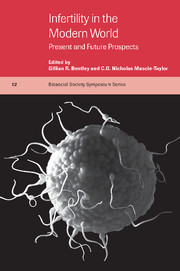Book contents
- Frontmatter
- Contents
- List of contributors
- 1 Introduction
- Part I Biomedical perspectives on fertility
- 2 Reproductive possibilities for infertile couples: present and future
- 3 Genetic influences on human infertility
- Part II Environmental influences on fertility
- Part III Social perspectives on infertility
- Index
2 - Reproductive possibilities for infertile couples: present and future
Published online by Cambridge University Press: 13 January 2010
- Frontmatter
- Contents
- List of contributors
- 1 Introduction
- Part I Biomedical perspectives on fertility
- 2 Reproductive possibilities for infertile couples: present and future
- 3 Genetic influences on human infertility
- Part II Environmental influences on fertility
- Part III Social perspectives on infertility
- Index
Summary
Abstract
Infertility affects at least 14% of the reproductive population world-wide. Modern technology can provide genetically related offspring to 80% of couples seeking treatment, and pregnancy to a further 10–15% using donated gametes. However, that only a small proportion is able to acquire suitable treatment, even in the West, highlights the social, economic and political difficulties surrounding available resources for assisted conception technology.
Before 1992 approximately 95% of severe male-factor infertility cases were offered sperm donation – unacceptable in many cultures. Since the development of intracytoplasmic sperm injection (ICSI), 90–95% of male-factor cases can now be offered the chance of their own genetic offspring. The use of egg donation and of surrogacy further expands opportunities for infertile couples to have children. In the former the recipient gestates and delivers her child, albeit genetically unrelated to herself, whilst in the latter the commissioning couple can have their genetic off-spring via host surrogacy. These technologies remain ethically challenging.
Developments in embryology technology have helped couples whose problem is one of implantation rather than conception, and this includes assisted hatching and zygote/embryo repair. The alliance of such technologies to the development of molecular genetics permits the biopsy of an eight- to ten-cell embryo for chromosome/genetics analysis on the extracted cells. This procedure has both social and economic advantages and makes it possible for couples to refrain from embarking on a pregnancy should the embryo carry a feared hereditary disorder.
- Type
- Chapter
- Information
- Infertility in the Modern WorldPresent and Future Prospects, pp. 17 - 45Publisher: Cambridge University PressPrint publication year: 2000
- 3
- Cited by



